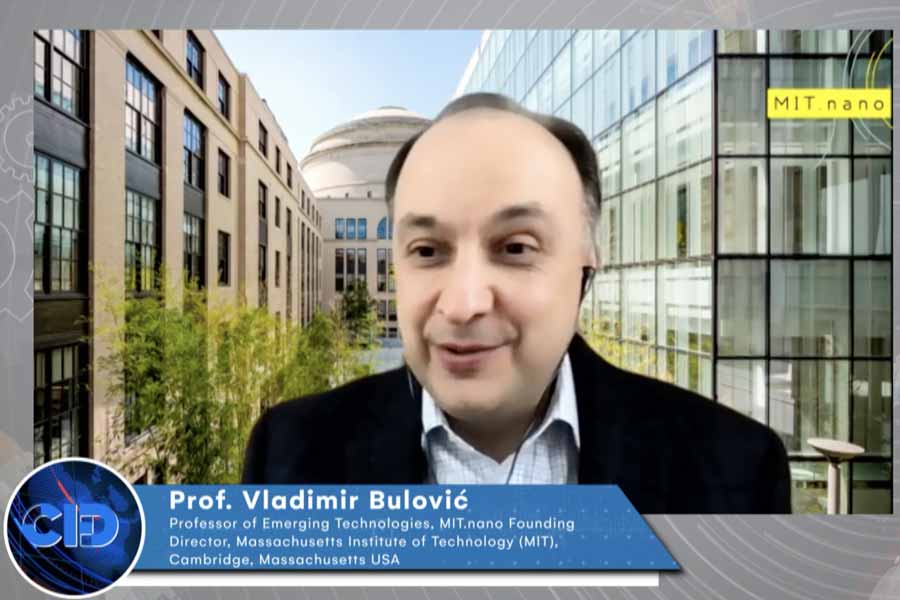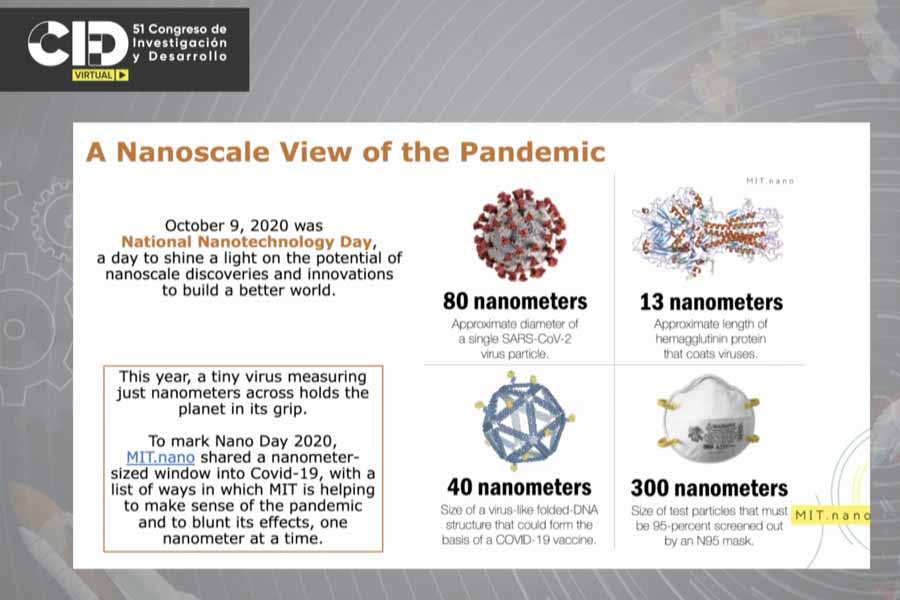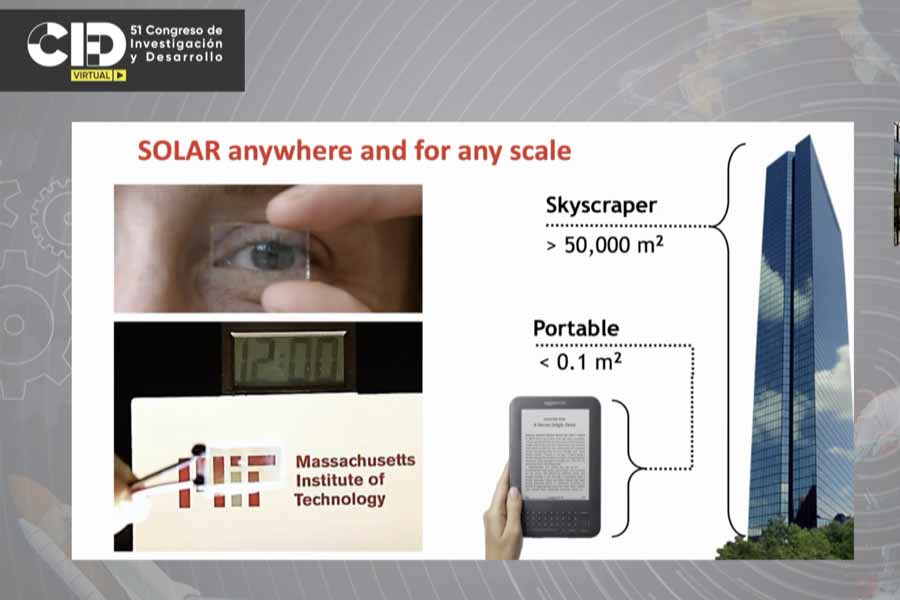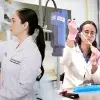“The future will be measured in nanometers. In fact, the industries of tomorrow will be thinking in nanokilometers. Being able to control these elements will dramatically change the wellbeing of this planet.”
This is what Dr. Vladimir Bulović, director and founder of MIT.nano, said in his presentation at Tec de Monterrey’s 51st Research and Development Conference about the importance of nanoscience to the future of humanity.
The professor from the Massachusetts Institute of Technology (MIT), also shared some of the research and innovations being carried out at this nanoscience laboratory, where Tec de Monterrey is also a collaborator.
“There are billion-dollar industries that have been revolutionized. It’s all about how we do things at the nanoscale,” he said.
A nanometer is a measure of length that is equal to one billionth of a meter, meaning that a meter is one billion nanometers long.

Present and future applications of nanotechnology
Dr. Bulović said that nanotechnology can be found in many different areas: in detergents with nanoscale molecules; in perfumes; and in garments such as anti-wrinkle shirts or stain-proof pants, to name but a few.
He believes that nanotechnology has had a big impact on Industry 4.0, permitting the development of new materials, 3D printing, and new opportunities for electronics, medicine, or mechanics, for example.
Industry 4.0 is a strategy to digitize traditional industry by incorporating new technologies.
The expert listed some of the noteworthy applications of nanotechnology:
- For detecting different viruses, such as SARS-CoV-2
Silver nanoparticles can be useful in accelerating the detection of Ebola, West Nile virus, Zika, dengue, and the virus that causes COVID-19, as they can change color when they come into contact with one of these viruses.
“You take a piece of paper, coat it with nanoparticles, and then put a drop of blood on the paper. This method allows you to see if the virus is present,” he explained.
He said that it is a quick and inexpensive medical diagnosis process that can detect diseases quicker.
“You take a piece of paper, coat it with nanoparticles, and then put a drop of blood on the paper. This method allows you to see if the virus is present.”
- Medical applications
He added that technologies have been developed for face masks and even medicines to create solutions that mitigate against COVID-19.
“Any kind of medicine you’ve taken definitely includes these nanoscales,” he said.
He also pointed out that many tools have been developed as a result of innovation in nanoscience, such as microscopes that allow Deoxyribonucleic Acid (DNA) to be easily observed and handled.
“Now we have the tools to see nanometer scales, we know, for example, that DNA is only two nanometers wide. This is how we discover new ways of looking at medicine,” said the director.

- The “electronic nose”
The researcher pointed out that the development of an “electronic nose” means it is now possible to know when fruit is about to ripen or to rot.
“The ripening process can be understood as a result of testing for the presence of ethylene. If you could detect the presence of ethylene in the air, you can tell if bananas or apples are about to ripen and are ready to be sold,” he explained.
He pointed out that industries dedicated to distributing this type of food could save large amounts of money with this “nose”.
This type of technology could even help detect materials like TNT.
“They are as good a technology for detecting explosives as any other methods available, such as dogs, which have enormous sensitivity,” he added.
- Organic displays with improved definition and efficiency
Different devices have been developed at the MIT.nano laboratory with mechanisms using nanotechnology, such as a printer producing molecular films used to make television screens and devices with OLED technology.
“There are Android and Apple phones that have this type of technology in their screens, and they are made using these types of tools,” he added.
These films have the ability to generate light when receiving electrical energy.
In addition to increasingly flexible screens with better image definition, nanotechnology is also used to manufacture light bulbs that are more efficient than incandescent lamps and even LED technology.

- Solar cells and rechargeable displays
The use of nanotechnology in the manufacture of solar cells was another area highlighted by the researcher during his presentation.
They are cells that can be printed in just minutes and are 20% of the thickness of a hair, which are flexible and weigh less than those which currently exist.
“They are cells that can be made into pieces of paper. You can make this cell so light that it could even exist within a bubble,” he said.
He explained that the sheets are translucent and designed to absorb only infrared light in order to generate an electrical current.
As a result of these qualities, the researcher imagined them being used on the screens of devices such as e-book readers, allowing them to recharge their batteries through exposure to sunlight.
“You can generate the necessary electricity for what you need. They could even be installed in the windows of a building and generate energy without you realizing that you’re looking at a solar cell,” he added.
The MIT.nano partnership with Tec de Monterrey
Bulović noted that the MIT.nano nanoscience laboratory opened its doors in October 2018, and that since then there has been a collaboration with Tec de Monterrey.
The Prototyping Laboratory in the building was even named “Tecnológico de Monterrey” in order to further develop the collaboration between the two institutions.
Thanks to the Tec-MIT partnership, for the last 6 years undergraduate and graduate students, as well as professors from various fields related to technology and engineering, have been able to collaborate on joint research projects.
Collaboration between the Tec and MIT in this field has was forged several years ago. In 2015, for example, the nanoLAB program was created so that students from the School of Engineering and Sciences could participate in summer stays.
“We’re proud of the Tec-MIT academic program which has supported the careers of those Tec de Monterrey engineers and scientists who wanted to focus on nanoscience and nanotechnology.
“There are students who come to take courses, and others who stay with us to do postdoctoral research. We also offer nanotechnology courses in the summer to more than 100 Tec de Monterrey participants,” he added.
He also highlighted the work carried out by researchers from both institutions to jointly publish scientific articles.
“The impact of MIT and Tec publications is greater when they are done together: when we work together, there are many documents and publications that reach high impact journals. That success is the result of collaboration,” he said.
The 51st Research and Development Conference
The 51st Research and Development Conference (CID) takes place from February 24 to 26. It’s an annual event that’s been held for over 50 years. This year, it’s online as a result of the pandemic.
It aims to share the results of the research carried out at the institution with both Mexican and global communities, and thereby connect society with knowledge in order to be able to have an impact on social, educational, economic, and health sectors, to name but a few.
“We want to be a university with research that generates more knowledge and finds solutions to problems within our society,” said David Garza, rector and executive president of the Tec.
ALSO READ:





